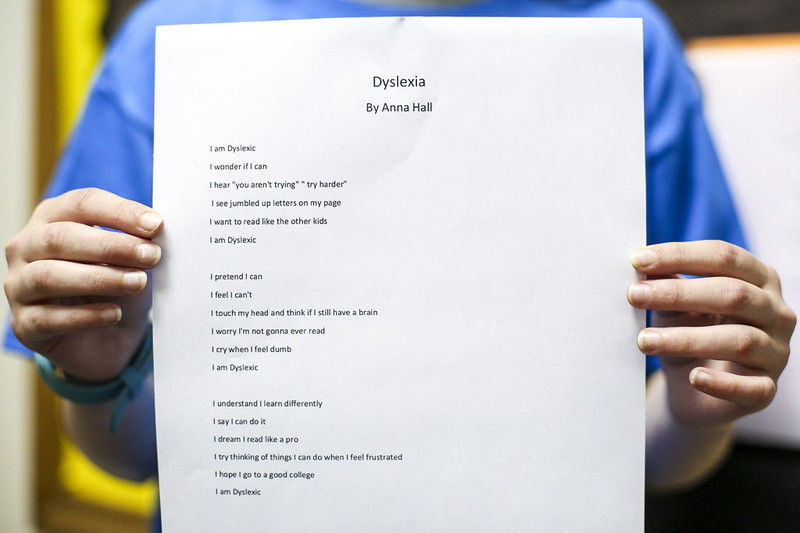Bridgemark Center helps students overcome learning disabilities, build confidence
Published 11:49 am Wednesday, June 14, 2017

- Anna Hall holds a poem she wrote about dyslexia at the Bridgemark Center in Tyler, Texas, on Monday, Feb. 27, 2017. Bridgemark Center specializes in education for children with learning disabilities such as dyslexia, dysgraphia and dyscalculia. (Chelsea Purgahn/Tyler Morning Telegraph)
Anna Hall’s dyslexia used to make her feel as if she would never be good enough. After just one week at Bridgemark Center, the 11-year-old already felt her confidence improving.
Bridgemark specializes in reaching students with dyslexia, dysgraphia and dyscalculia. The school is modeled after the Shelton School in Dallas, a pioneer in teaching students with learning disabilities.
Bridgemark operates under Calvary Baptist Church, much like an arm of the church’s ministry, Executive Director Jaime Warren said.
Warren said Bridgemark began when she and Wendy Baker saw a need schools simply weren’t able to fill. They needed to find a way to bring students into a low-stress environment where they didn’t feel inadequate.
Every instructor at Bridgemark is trained to teach students with learning disabilities.
A day in the life of students at Bridgemark starts with physical and mental exercises to wake up the brain and dissipate a bit of excess energy. Throughout the day, students are encouraged to use nontraditional desks with pedals or even balance boards if movement helps them stay on task.
“We like for everything we do to be intentional,” Warren said. “We can meet the needs of each individual student.”
Instead of punishing students if they get fidgety, Bridgemark looks for ways to channel that energy into academic and creative energies.
“All the teachers love me like my family and they understand,” Anna said.
Anna’s mother Heather Hall said the family moved to Tyler specifically for the opportunity for Anna to attend Bridgemark.
If a student is having a hard time focusing due to their learning disability, often that energy might be negatively redirected in a traditional classroom setting. At Bridgemark, the students don’t feel out of place or as if they aren’t good enough. Teachers can take the time to focus on the problems the student is having because the classes are so small and targeted toward specific needs.
“It’s a world of difference from head down, shoulders slumped to the tears because she just couldn’t put those words together to read like the other kids,” Ms. Hall said.
The individualized pace of the environment has allowed Anna to learn without feeling pressured or out of place. Grades also participate in common themes. When younger students are learning about the origin of literature, the upper grades may be putting the techniques into play by writing poetry. As students walk through the hallways, they see the common lessons highlighted on boards outside the classrooms.
Madelynn Crow, a ninth-grade student said she also struggled in a standard classroom setting.
“They make you feel like everyone is special here,” Madelynn said. “You’re not that awkward person that can’t read or do math.”
During recent poetry-centered lessons Anna wrote about how her dyslexia made her feel before moving to Bridgemark.
“I hear ‘You aren’t trying, try harder,'” she wrote “I cry when I feel dumb.”
Today Anna will be the first person to tell you that she is smart, her mother said. Anna has put herself on track to one day attend Baylor University.
Warren said often new students come to the school with social and emotional issues related to their learning difficulties. She said the teachers work to make teach student feel valued.
“You give kids labels based on testing, but every child’s dyslexia looks different,” she said.
Teachers have a wide array of tools at their disposal, but the school puts a particularly strong emphasis on keeping the students active.
Warren said students work best when they are getting enough physical activity. Breaking up lessons with frequent activity helps keeps students fresh while dealing with repetition. Warren said some students might need to repeat something dozens of times before it clicks.
“Repetition is important. We try to make it interesting to avoid burnout,” she said. “The brain likes novelty, variety and choices.”
Madelynn said she has loved the school.
“It’s an amazing experience for anyone who wants to come here,” she said. “It’s about you, not the lesson.”
Since Bridgemark opened in 2014, they have had three students graduate high school. Those students were able to not only thrive in the new setting, but also complete dual credit courses at Tyler Junior College.
Warren said building confidence translates to success for their students.
“When you can see the evidence (of their hard work), that’s one of the most rewarding moments ever,” she said.
Bridgemark has more than 60 students in first through eighth grades, as well as a handful of high school students and others who spend half the day working on core classes such as English, math and social studies before going to their home campus.
For more information, visit bridgemarkcenter.com
Twitter: @TMT_Cory
“Dyslexia”
By Anna Hall
I am Dyslexic
I wonder if I can
I hear “you aren’t trying” “try harder”
I see jumbled up letters on my page
I want to read like the other kids
I am Dyslexic
I pretend I can
I feel I can’t
I touch my head and think if I still have a brain
I worry I’m not gonna ever read
I cry when I feel dumb
I am Dyslexic
I understand I learn differently
I say I can do it
I dream I read like a pro
I try thinking of things I can do when I feel frustrated
I hope I go to a good college
I am Dyslexic







